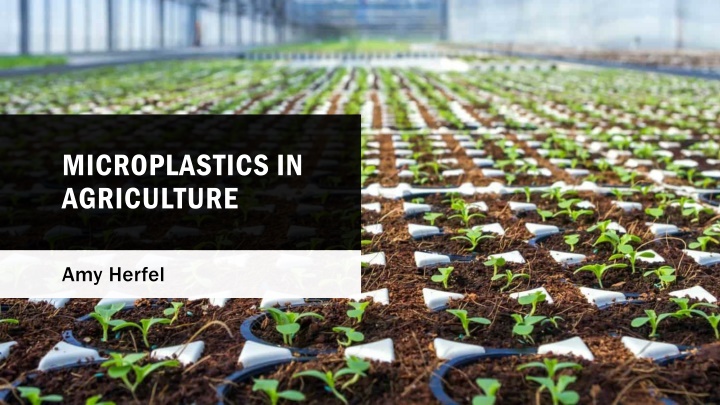
Microplastics in Agriculture and Possible Solutions
Explore the history of plastics, the impact of microplastics in agriculture, and possible solutions to mitigate their harmful effects. Learn about the use of plastic in agriculture, its impact on the environment and human health, and potential regulations to address the issue.
Download Presentation

Please find below an Image/Link to download the presentation.
The content on the website is provided AS IS for your information and personal use only. It may not be sold, licensed, or shared on other websites without obtaining consent from the author. If you encounter any issues during the download, it is possible that the publisher has removed the file from their server.
You are allowed to download the files provided on this website for personal or commercial use, subject to the condition that they are used lawfully. All files are the property of their respective owners.
The content on the website is provided AS IS for your information and personal use only. It may not be sold, licensed, or shared on other websites without obtaining consent from the author.
E N D
Presentation Transcript
MICROPLASTICS IN AGRICULTURE Amy Herfel
HISTORY OF PLASTICS Microplastics in the agriculture industry is a relatively new problem First fully synthetic plastic called Bakelite was created in created in 1907 by Leo Baekeland. Plastics Industry boomed in WWII due to wartime efforts.
MICROPLASTICS Despite widespread use of plastic, Microplastics were only discovered in 2004. Professor Richard Thompson and his team were the first to show that microplastics have accumulated in oceans since the 1960s. Microplastics in human blood for the first time in 2022 (scientists found particles in almost 80% of test subjects)
USE IN AGRICULTURE The agricultural sector is one of the biggest users of intentionally added micro plastics Plastic is used to coat pesticides and fertilizers which serves as a controlled release function The market for microencapsulated pesticides is expected to reach $817 million by 2025, signifying an 11% growth since 2018
Synthetic polymer materials do not degrade well. Instead, they accumulate in the soil over time Microplastics can penetrate edible fruits and vegetables and then can enter the food chain. IMPACT Linked to serious health issues including endocrine disruption, decreased reproductive health, and cancer.
POSSIBLE SOLUTIONS Slow-release pesticides and fertilizers are a beneficial technology. One solution to preserve the function but reduce harm is to used biodegradable bioplastics. These bioplastics could be derived form corn-starch or other plant-based materials which will break down in soil, preventing accumulation.
REGULATION To promote the move to biodegradable plastic regulations is likely need. The Food and Agriculture administration of the United Nations recommended banning non-biodegradable polymer-coated fertilizer, seed coatings, and pesticides in their 2021 report. In the US regulation such as this would affect states with more farms such as Texas , Missouri, and Iowa.
While legislation is slow, here are other actions that can improve this issue IN THE MEAN TIME Require Companies to disclose the amount of microplastics they are using in their products. More research needs to be performed. Currently, severely lacking data in this area.
WRAP UP What Existed in the past? Microplastic have likely been around since the widespread use of plastic, but their effects were no always studied. How has that situation improved? Unfortunately, this situation hasn t yet improved. Currently, unless addressed by legislation this problem is predicted to become worse. What are the scenarios for the future and what will need to occur to reach each potential outcome, particularly outcomes with an improved circularity? Biodegradable seed coatings Regulation Research and disclosure




